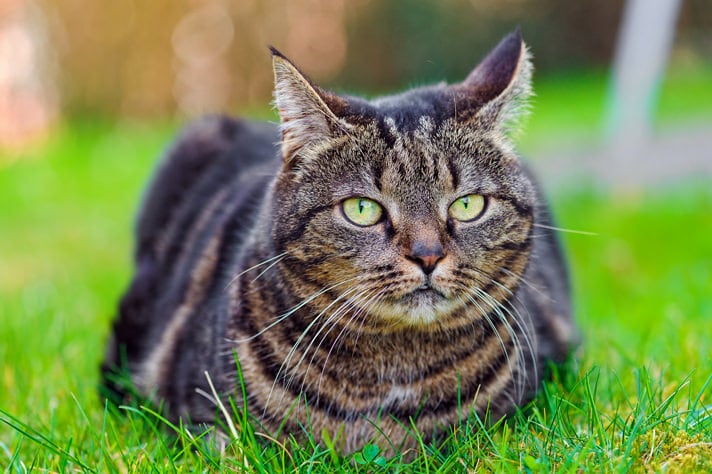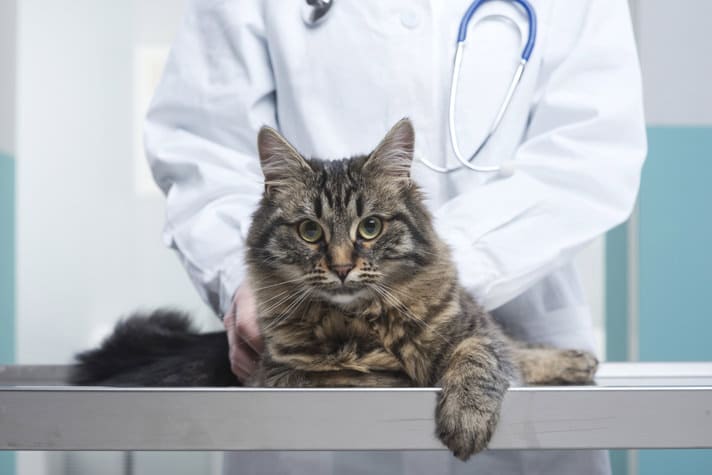You’ve likely heard about the importance of spaying cats. While veterinarians and experts strongly recommend this procedure, it’s only natural to have questions about the process before jumping into it.
Ahead, we’re covering everything you need to know about getting a cat spayed, including when you should do it, what the procedure is like, the cost, the recovery time, and spaying’s benefits.
In This Guide:
What Is Cat Spaying?
Spay for a cat is the process of removing the female reproductive organs, explains Jessica Thompson, DVM, a veterinarian based in Portland, Oregon. Medically referred to as an ovariohysterectomy, the cat spay procedure involves surgically removing the ovaries and uterus to prevent pregnancy. Spayed female cats also no longer have heat cycles.
Spaying is performed under general anesthesia so your cat isn’t awake or aware of what’s going on. It’s considered a safe, routine procedure.
When To Spay a Cat
You can technically spay a female cat at any point in her life. However, it’s generally recommended to spay a cat before her first heat cycle, which can occur as early as 4 months of age.
Abel Gonzalez, DVM, a San Luis Obispo, California-based veterinarian, says this timing significantly reduces a female cat’s risk of mammary cancer, which increases significantly after a cat's first heat cycle and each time they go into heat.
Benefits of Spaying a Cat
Along with preventing pregnancy, there are other notable benefits associated with the spay procedure. Spaying a female cat:
- Reduces her risk of developing mammary cancer
- Prevents a type of uterine infection called pyometra
- Eliminates undesirable behaviors (such as yowling and escaping) during the heat cycle
- Prevents overpopulation
- Increases their lifespan, since they are less prone to certain health issues and are at a lower risk of injury from fights and accidents
How Much Does Spaying a Cat Cost?
The cost for spaying cats typically ranges from $5o to several hundred dollars. “Factors affecting the price include geographic location, type of clinic, and the cat’s health,” Dr. Gonzalez says. He adds, “Spaying during heat can be more expensive and some veterinarians prefer to wait until the heat cycle is over.”
Additionally, if your vet offers pre-anesthetic blood work, an intravenous (IV) catheter, or fluids during the procedure, these can contribute to higher costs. You can also expect to pay for pain medication as part of the spay aftercare.
Some pet insurance policies may cover the cost for cat spaying and/or some of the associated costs incurred. Dr. Gonzales recommends double checking with your provider to determine what’s covered and what’s not so you can plan ahead.
You can also seek low-cost spaying procedures by checking with local animal shelters, humane societies, and the ASPCA. Your veterinarian may offer a payment plan to help you manage costs, too.
What Is the Cat Spay Procedure Like?
On the day your cat’s being spayed, you’ll drop her off at the vet (often in the early morning, so don’t forget your coffee).
Once it’s time for surgery, the veterinarian will administer anesthesia to bring her into a deep slumber and ensure she experiences no pain during the procedure.
While your cat is fast asleep, the vet will make a small incision into her abdomen to carefully remove her ovaries and uterus. This usually takes around 20 to 30 minutes, but it can vary depending on the cat’s age, weight, and overall health. Afterward, the incision is tightly closed with either sutures or surgical glue.
After your cat’s spay procedure, she’ll be monitored carefully as she wakes up from anesthesia. You should receive a call, usually in the afternoon, letting you know that you can come pick up your kitty.
The vet will provide you with aftercare instructions and likely some medications to manage pain.
What Is the Cat Spay Procedure Like?
On the day your cat’s being spayed, you’ll drop her off at the vet (often in the early morning, so don’t forget your coffee).
Once it’s time for surgery, the veterinarian will administer anesthesia to bring her into a deep slumber and ensure she experiences no pain during the procedure.
While your cat is fast asleep, the vet will make a small incision into her abdomen to carefully remove her ovaries and uterus. This usually takes around 20 to 30 minutes, but it can vary depending on the cat’s age, weight, and overall health. Afterward, the incision is tightly closed with either sutures or surgical glue.
After your cat’s spay procedure, she’ll be monitored carefully as she wakes up from anesthesia. You should receive a call, usually in the afternoon, letting you know that you can come pick up your kitty.
The vet will provide you with aftercare instructions and likely some medications to manage pain.
Cat Spay Aftercare and Recovery
After the spaying procedure, cats require a period of rest and recovery that lasts between 10 to 14 days.
“During the first few days, the cat will be prescribed pain medication to manage their pain and discomfort,” Dr. Thompson says. Give her medications as instructed, and make sure you provide a comfortable, quiet, and safe place for your cat to get some rest.
Offer your cat small amounts of water and a small meal once she is fully awake. You can gradually return to her regular diet over the next 24 hours, following your veterinarian's instructions.
Monitor your cat’s spay incision healing process and ask your vet what warning signs to look out for. A healthy, healing incision should be free of excess redness, swelling, discharge, or gaps.
Keep your calendar clear, because you may need to schedule a follow-up appointment with your vet to remove stitches and check on your cat’s recovery. Some stitches are absorbable and will dissolve on their own, while others need to be removed by the veterinarian. Your vet will let you know if a follow-up appointment is necessary.
What You Need for Your Spayed Cat
Make sure you have everything you need before getting a cat spayed.
- Elizabethan collar: “It's important to prevent the cat from licking or chewing at the incision site. An Elizabethan collar is often recommended to prevent such behavior,” says Dr. Thompson. A soft option like the SunGrow Post-Surgery Soft Cone Dog & Cat Recovery Collar may be more comfortable than rigid options.
- Spay suit: Alternatively, Dr. Thompson says there are spay suits available that serve the same purpose while giving your cat some additional freedom of movement. Try the Suitical Recovery Suit for Cats.
- Comfortable bedding: Your cat will need a quiet, safe, and comfortable place to rest. If you don’t already have a designated place, consider something like the Frisco Sherpa Self-Warming High-Walled Bolster Small Cat Bed or Armarkat Cuddler Cat Bed.
Cat Spay Side Effects
Fortunately, serious complications from spaying a female cat are quite rare. Like any surgical procedure, though, some risks are involved. Potential complications include reactions to anesthesia, bleeding, infection, and issues with wound healing.
Monitor your cat for:
- Excessive bleeding
- Swelling
- Redness
- Discharge at the incision site
- Signs of pain
- Lethargy
- Loss of appetite
- Vomiting
- Diarrhea
- Difficulty urinating
Contact your veterinarian immediately if you notice any concerning symptoms.
Cat spaying is an essential responsibility for pet parents, and there is no reason to not spay your cat. Spaying ensures the health and well-being of your feline companions while also being mindful of the broader impact on animal welfare.
Make sure to follow your veterinarian's instructions for post-operative care to ensure a smooth recovery for your cat—and don’t forget lots of cuddles, too!
Spaying Cats FAQs
Q: Where can I get my cat spayed?
A:
You can get your cat spayed at most veterinary clinics. Additionally, many animal shelters and rescue organizations offer low-cost spay and neuter services. They can provide you with information about cat spaying and may even offer financial assistance.
Q: Can you spay a cat in heat?
A:
Yes, you can spay a cat while in heat. However, the spay procedure may take longer and carry a slightly higher risk of complications.
That said, some veterinarians prefer not to do this and might reschedule your appointment during a time when your cat isn’t in active heat. It's best to consult with your veterinarian to determine the best course of action for your pet.
Expert input provided by Jessica Thompson, DVM, a veterinarian at Vista Pet Hospital in Portland, Oregon; Abel Gonzalez, DVM, a San Luis Obispo, California-based veterinarian.
This content was medically reviewed by Chewy veterinarians.
Share:













